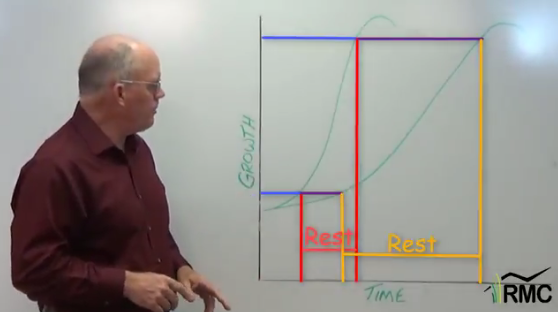First we need to clarify what sort of perennial forage stand we are managing. The answer will be different for pure or very dominant legume or grass swards.
Alfalfa and hay fields with high concentrations of alfalfa hay.

After 30 days or so most alfalfa stands will want to start blooming. Once we have 25% or more bloom, there will be little further growth even with good rains. Leafhopper pressure is often present at a concentration over or nearly over the threshold for mitigation at this point. Your best choice is to cut rather than spray and wait for the withholding time. You should begin to sweep newly cut fields at 10 -14 days post cut to be sure that leafhopper pressure is not too great to preclude new regrowth as the rains come. Ideally, you should be soil testing and have a fertility program in place. If your cutting schedule has stayed on target up to this point in the season, stay with your fertility application schedule. If you have not removed nutrients with frequent cuttings, hold off putting down new fertilizer applications. Remember that potash and boron can be very limiting nutrients to a healthy, productive stand. Even if old growth is so short that you cannot gather it up, your best option is to clip the stand and let it lie. When the rains return, you will be in a great position to capture the nutrients and grow a harvestable cutting.
Grass Stands
Grasses like orchardgrass and tall fescue that are only 5-10 inches tall and showing browning and wilted leaves are best left uncut. If you have a lot of annual weeds coming through you may want to clip them, but keep the cutter bar high – 5-6 inches – to be certain not to damage the dormant plants. Here again, if you are on a normal fertility program, consider the annual DM yield so far. It is wise, however, to delay fertility application until the drought is fully broken. Do not push nitrogen too hard in the fall, as warm soils naturally release more N in late summer, especially after a drought breaks. Be sure to use a form of nitrogen that is stable, either Ammonium Sulfate or a good stabilizer product on the N. Timing this with a good shower can really boost the grass. Keep in mind that the carbohydrate reserves are in the bottom 3-4 inches of grass stems, and we want to be sure to preserve these for optimal regrowth.
Drought stress demands that grazing operations slow rotations down to allow a much longer rest between grazing episodes. Resist the temptation to allow the animals to nub the grass down to the very short 1-2 inch residual heights. Although it is painful to open up “winter” stockpiles of forage, your sward will return to productivity much quicker and thrive in the long term if you give it rest. Stopping now may allow you some late fall grazing days or some opportunities to make some stored feed to replenish supplies used now. If you keep intensively grazing these stressed stands, you may not see adequate regrowth for winter stand survival when fall rains return.
If your stands are really thin you may consider interseeding a small grain or annual ryegrass to boost fall and winter production and take off a big harvest in spring to build forage inventory. (Then, you may want to consider renovating the stand by rotating into a summer and/or winter annual before reseeding the pasture.)
On mixed stands you may want to mow high or just wait it out. The strong desire to “do something” may need to be quelled to allow your fields to recover. Add a little patience to your plans, and you won’t be disappointed.




